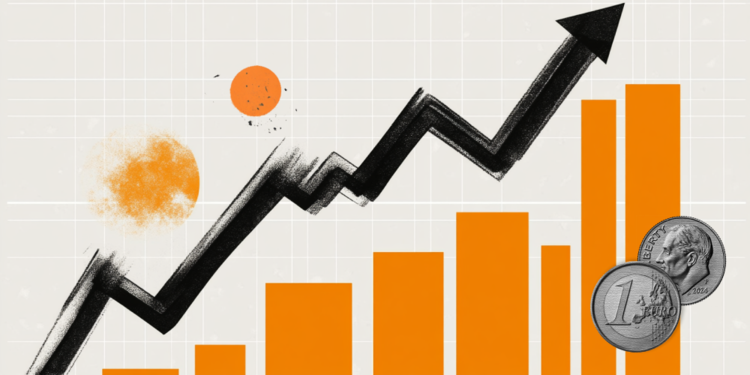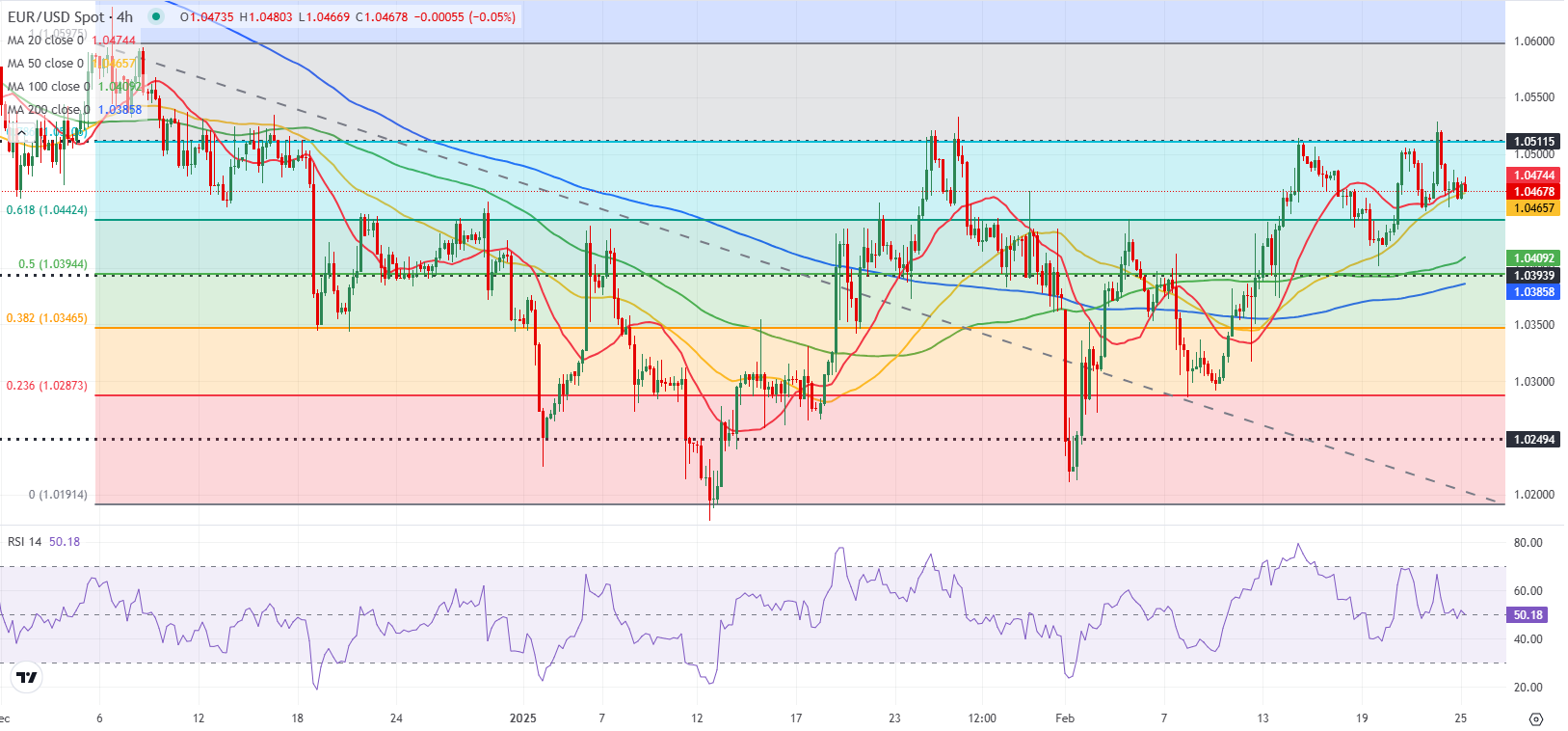- EUR/USD moves sideways in a narrow channel below 1.0500 early Tuesday.
- Investors await Negotiated Wage Rates data from the Eurozone and Consumer Confidence data from the US.
- The near-term technical outlook points to a loss of bullish momentum.
After reaching a multi-week high at the weekly opening, EUR/USD lost its traction and closed the day flat below 1.0500. The pair moves up and down in a very tight channel above 1.0450 as investors await key macroeconomic data releases.
Euro PRICE Last 7 days
The table below shows the percentage change of Euro (EUR) against listed major currencies last 7 days. Euro was the strongest against the Canadian Dollar.
| USD | EUR | GBP | JPY | CAD | AUD | NZD | CHF | |
|---|---|---|---|---|---|---|---|---|
| USD | 0.18% | 0.12% | -1.43% | 0.61% | 0.36% | 0.24% | -0.46% | |
| EUR | -0.18% | -0.06% | -1.59% | 0.43% | 0.18% | 0.06% | -0.64% | |
| GBP | -0.12% | 0.06% | -1.52% | 0.49% | 0.24% | 0.12% | -0.58% | |
| JPY | 1.43% | 1.59% | 1.52% | 2.05% | 1.80% | 1.66% | 0.96% | |
| CAD | -0.61% | -0.43% | -0.49% | -2.05% | -0.25% | -0.37% | -1.07% | |
| AUD | -0.36% | -0.18% | -0.24% | -1.80% | 0.25% | -0.13% | -0.86% | |
| NZD | -0.24% | -0.06% | -0.12% | -1.66% | 0.37% | 0.13% | -0.70% | |
| CHF | 0.46% | 0.64% | 0.58% | -0.96% | 1.07% | 0.86% | 0.70% |
The heat map shows percentage changes of major currencies against each other. The base currency is picked from the left column, while the quote currency is picked from the top row. For example, if you pick the Euro from the left column and move along the horizontal line to the US Dollar, the percentage change displayed in the box will represent EUR (base)/USD (quote).
The Euro started the week on a bullish note as markets reacted to the German election outcome. Later in the day, the negative shift seen in risk mood helped the US Dollar (USD) stay resilient against its rivals and caused EUR/USD to stretch lower.
Later in the session, the European Central Bank (ECB) will publish Negotiated Wage Rates for the fourth quarter. A reading above 5.5% could support the Euro with the immediate reaction, while a print below 5% could hurt the currency.
In the second half of the day, the Conference Board will publish the Consumer Confidence Index data for February. Investors will also pay close attention to political headlines as US President Donald Trump is expected to sign new executive orders. A bearish opening in Wall Street, followed by a sharp decline in major equity indexes, could help the USD hold its ground and make it difficult for EUR/USD to regain its traction. At the time of press, US stock index futures were down between 0.1% and 0.2%.
EUR/USD Technical Analysis
The Relative Strength Index (RSI) indicator on the 4-hour chart moves sideways at around 50, reflecting EUR/USD’s indecisiveness.
On the upside, 1.0500-1.0510 (round level, Fibonacci 78.6% retracement of the latest downtrend) could be seen as first resistance before 1.0550 (static level) and 1.0600 (beginning point of the downtrend). On the flip side, supports could be spotted at 1.0440 (Fibonacci 61.8% retracement), 1.0390-1.0400 (100-period Simple Moving Average (SMA), 50-day SMA, Fibonacci 50% retracement of the latest downtrend) and 1.0350 (Fibonacci 38.2% retracement).
Euro FAQs
The Euro is the currency for the 19 European Union countries that belong to the Eurozone. It is the second most heavily traded currency in the world behind the US Dollar. In 2022, it accounted for 31% of all foreign exchange transactions, with an average daily turnover of over $2.2 trillion a day. EUR/USD is the most heavily traded currency pair in the world, accounting for an estimated 30% off all transactions, followed by EUR/JPY (4%), EUR/GBP (3%) and EUR/AUD (2%).
The European Central Bank (ECB) in Frankfurt, Germany, is the reserve bank for the Eurozone. The ECB sets interest rates and manages monetary policy. The ECB’s primary mandate is to maintain price stability, which means either controlling inflation or stimulating growth. Its primary tool is the raising or lowering of interest rates. Relatively high interest rates – or the expectation of higher rates – will usually benefit the Euro and vice versa. The ECB Governing Council makes monetary policy decisions at meetings held eight times a year. Decisions are made by heads of the Eurozone national banks and six permanent members, including the President of the ECB, Christine Lagarde.
Eurozone inflation data, measured by the Harmonized Index of Consumer Prices (HICP), is an important econometric for the Euro. If inflation rises more than expected, especially if above the ECB’s 2% target, it obliges the ECB to raise interest rates to bring it back under control. Relatively high interest rates compared to its counterparts will usually benefit the Euro, as it makes the region more attractive as a place for global investors to park their money.
Data releases gauge the health of the economy and can impact on the Euro. Indicators such as GDP, Manufacturing and Services PMIs, employment, and consumer sentiment surveys can all influence the direction of the single currency. A strong economy is good for the Euro. Not only does it attract more foreign investment but it may encourage the ECB to put up interest rates, which will directly strengthen the Euro. Otherwise, if economic data is weak, the Euro is likely to fall. Economic data for the four largest economies in the euro area (Germany, France, Italy and Spain) are especially significant, as they account for 75% of the Eurozone’s economy.
Another significant data release for the Euro is the Trade Balance. This indicator measures the difference between what a country earns from its exports and what it spends on imports over a given period. If a country produces highly sought after exports then its currency will gain in value purely from the extra demand created from foreign buyers seeking to purchase these goods. Therefore, a positive net Trade Balance strengthens a currency and vice versa for a negative balance.
















